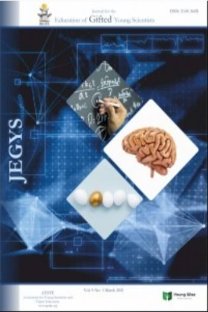Teaching English Activities for the Gifted and Talented Students
This paper reviews the literature and recommends activities that can be used to teach English to gifted and talented students. It includes the responsibilities that teachers of the gifted and talented have in teaching the English language. Strategies for teaching the language in a natural and flowing way to increase intake and usage are also presented. Also discussed are the pressures on gifted and talented students when they are learning a new subject such as the English language and how these pressures occur because of beliefs about giftedness and how gifted learners learn. Teachers need to also be aware of the linguistic and cultural backgrounds of their students. This information can be used to help students speak English more naturally during informal talks/discussions in class about their different lifestyles and/or cultural features. The special and different learning characteristics of gifted students are important for their teachers to know. Teachers of gifted students should then use that knowledge when they differentiate curriculum. To be a teacher of these special children means being open to ongoing professional development and always focusing on the learner rather than the learning. Finally, the teachers of the gifted need to shift their approaches in order to become counsellors and guides more than instructors and directors of learning.
Keywords:
English teaching teaching activity, gifted and talented,
___
- Clickenbeard, P. R. (1991). “Unfair Expectations: A Pilot Study of Middle School Students’ Comparisons of Gifted and Regular Students” Journal for the Education of the Gifted, vol.15, No. 1
- Coil, C. (2012). Ten myths about gifted students. Retrieved 20/03/2014 from http://schoolsofthought.blogs.cnn.com/2012/11/14/ten-myths-about-gifted-students-and-programs-for-gifted/
- Coyle, D. (1999). Theory and planning for effective classrooms: supporting students in content and language integrated learning contexts in Masih, J. (ed.) Learning through a foreign language, London: CILT.
- Faulkner, H. (2003). Predicting gifted foreign language learning and performance. Retrieved 12/08/2013 from http://etheses.nottingham.ac.uk/3081/
- Freeman, J. (1998) "Educating the Very Able: Current International Research". London: The
- George, P. (1995) Talent Development and Grouping in the Middle Grades: Challenging the Brightest Without Sacrificing the Rest” Middle School Journal, Vol.15, no4 (12-17).
- Hayes, P., Norris J, Flaitz J (1998). Evidence of language problems in underachieving gifted adolescents: Implications for assessment. J. Secondary Gifted Educ. Summer, 9(4): 179-194.
- Heacox, D. (2009). Making differentiation a habit: how to ensure success in academicallydiverse classrooms. Retrieved 11/02/2014 fromhttp://www.cca.k12.ia.us/admin/ProfDev/TFLD.pdf
- Hoh, P. (2005). The Linguistic Advantage of the Intellectually Gifted Child: An Empirical Study of Spontaneous Speech. Roeper Rev., Spring, 27(3): 178-185.Iowa Department of Education The Connie Belin and Jacqueline N. Blank International Centerfor Gifted Education and Talent Development (2008). Retrieved 12/12/2013 from https://www.educateiowa.gov/sites/files/ed/documents/IdentifyGiftedTalentedELL.pdf
- Kaplan, S. (1999) Teaching up to the needs of the gifted English Language Learner. Retrieved 06/10/2013from http://txgifted.org/wp-content/uploads/files2/tempo/1999-2.pdf
- King, K.A., Kozleski, E.B., Lansdowne , K. (2009) Where are all the students of color in gifted education? Retrieved 28/03/2014 from http://www.naesp.org/resources/2/Principal/2009/M-J_p16.pdf
- Lafferty, S. (No date available) Meeting the needs of Academically Gifted. Retrieved 11/11/2013 from http://go.hrw.com/resources/go_sc/gen/HSTPR078.PDF
- Myths, Arguments and Red Herrings (no date available) Retrieved 20/03/2014 from http://www.hoagiesgifted.org/arguments.htm
- Orange County Public schools Gifted Education Program handbook: Serving the needs of gifted learners. Retrieved 12/08/2013 fromhttps://teacher.ocps.net/marta.heistand/media/giftedhandbook200910.pdf
- Porter, L.(1999) Gifted young children. Buckingham: Open University Press Stationery Office quoted by Dust, K. (2001) "Expanding Minds" Report(The Magazine from the Association of Teachers and Lecturers) March 2001 p.l5
- Renzulli, J. S. (1986). The three-ring conception of giftedness: A developmental model forcreative productivity. In R. J. Sternberg & J. E. Davidson (Eds.), Conceptions ofgiftedness (pp. 53-92). New York: Cambridge University Press.
- Schmidt, O. (2004). Accent on Essential Life Skills, Toronto, Canada.
- Scottish Network for able pupils, guidance for addressing the needs of highly able pupils (2004) Retrieved 28/03/2014 from http://www.gla.ac.uk/media/media_138127_en.pdf
- South Carolina Gifted and Talented Best Practices Manual (2006) http://ed.sc.gov/agency/programsservices/123/documents/SCGiftedandTalentedBestPracticesManual.pdf adresinden 10/10/2013 tarihinde erişilmiştir.
- Tedick, D.J., de Gortari, B. (1998). Research on error correction and implications for classroom teaching. Retrieved 23/03/2014 from http://www.carla.umn.edu/immersion/acie/vol1/Bridge1.3.pdf
- Tomlinson, C. A. (1997) in Lafferty, S. M. (Ed.)(t.y) Meeting the needs of the academically gifted Gifted and talented international. Retrieved 09/09/2013 from http://go.hrw.com/resources/go_sc/gen/HSTPR078.PDF
- Understanding Language Teaching from method to postmethod (2011) Retrieved 25/03/2014 from http://livelongday.files.wordpress.com/2011/08/kumaraposmethod.pdf
- Van Tassel-Baska J (2000). The on-going dilemma of effective identifycation practices in gifted education. The Communicator, Vol. 31.
- Başlangıç: 2013
- Yayıncı: Genç Bilge Yayıncılık
